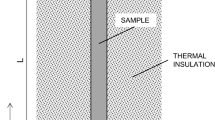Abstract
The hot wire technique is widely used to determine the thermal properties of materials. Commonly, this technique is developed for considered infinite radius of cylindrical mediums. Here, we propose an analytical solution of the heat conduction problem in an insulated finite sample. The derived temperature solution is found mathematically to be non-regular convergent series, and lead to avoid the assumption of infinite geometries, difficult to realize in practice. The first part of this paper concerns the study of the calculability of this series. The second one deals with the thermal properties estimation. The sensitivity study shows that the estimation procedure is feasible either using the concept of the time of the maximum rising temperature or, when exploring large time measurements, using the least squares minimisation that has an equivalent pure graphical procedure.








Similar content being viewed by others
References
Wakeham WA, Assael MJ. Measurement, instrumentation and sensors handbook. Boca Raton: CRC Press; 2000.
Hladik J. Métrologie des propriétés thermo-physiques des matériaux. Paris: Masson; 1990.
Degiovanni A, Benjamin R, Métrologie thermique : une histoire, un appareil, une application, JITH—Tanger—Maroc—15/17 novembre 2005.
Gustavsson M, Karawacki E, Gustafsson SE. Thermal conductivity, thermal diffusivity and specific heat of thin samples from transient measurements with hot disk sensors Rev. Sci Instrum. 1994;65:3856–9.
Parker WJ, Jenkins RJ, Butler CP, Abbott GL. Flash method of determining thermal diffusivity, heat capacity, and thermal conductivity. J Appl Phys. 1961;32:1679.
Watt DA. Theory of thermal diffusivity by pulse technique. Brit J Appl Phys. 1966;17:231.
Vozar L, Hohenauer W. Flash method of measuring the thermal diffusivity. A review. High Temp-High Press. 2003;35:253.
Tian F, Sun L, Mojumbar S, Prasad R. Absolute measurement of thermal conductivity of poly(acrylic acid) by transient hot wire technique. J Therm Anal Calorim. 2011;104(3):823.
Sassi MBH, Dos Santos CAC, Da Silva ZE, Gurgel JM, Jose PA Jr. Heat conduction models for the transient hot wire technique. High Temp-High Press. 2009;2(38):97–117.
Carslaw HS, Jaeger JC. Operational methods in applied mathematics. London: Oxford University Press; 1953.
Zauderer E. Partial differential equations of applied mathematics. New Jersey: Wiley; 2006.
Özisik MN. Heat conduction. New York: Wiley; 1993.
Abramowitz M, Stegun IA, Handbook of mathematical functions, US Department of Commerce, National Bureau of Standards Applied Mathematics, May 1968.
Kurpisz K, Nowak AJ. Inverse thermal problems. Boston: Computational Mechanics Publications; 1995.
Beck JV, Woodbury KA. Inverse problems and parameters estimation: integration of measurements and analysis. Meas Sci Tech. 1998;9:839.
Beck JV, Arnold KJ. Parameter estimation in engineering and science. New York: Wiley; 1977.
Minkowycz WJ, Sparrow EM, Schneider GE, Pletcher RH, editors. Hand-book of numerical heat transfer. New York: Wiley; 1988.
William HP, Brian PF, Saul AT, William TV. Numerical recipes (FORTRAN version). New York: Cambridge University Press; 1990.
Author information
Authors and Affiliations
Corresponding author
Rights and permissions
About this article
Cite this article
Sassi, M.B.H., Boutaous, M. Development of the hot wire technique for finite geometry samples. J Therm Anal Calorim 117, 943–951 (2014). https://doi.org/10.1007/s10973-014-3837-9
Received:
Accepted:
Published:
Issue Date:
DOI: https://doi.org/10.1007/s10973-014-3837-9




